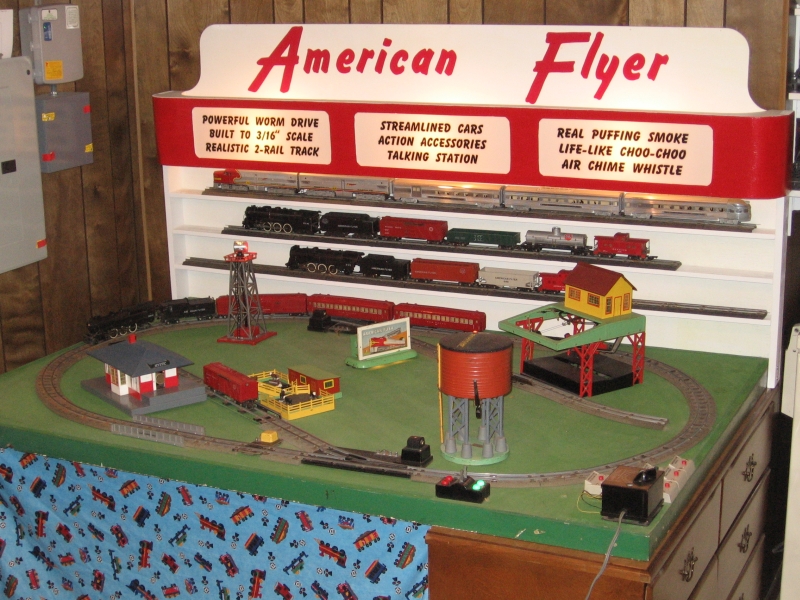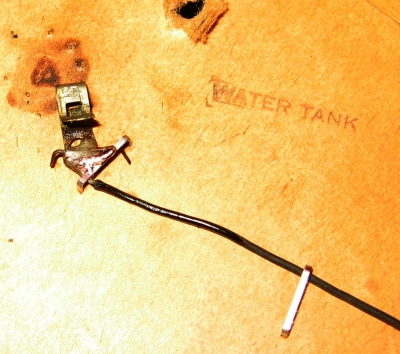History and Description of the Layout
This Layout was originally used in Gambles Department store
in Fergus Falls, Minnesota . This was confirmed by the wife of the
store manager, who ran the store from 1940 - 1970. She
remembers that it was sold to the family of the previous owner. She
thought that the green paint may have been applied in the store at one time
or another along with the 1/4 round molding on the edges. It was a
birthday present which the previous owner received on December 29, 1956
along with a "New Black Diamond" train set, number 5615T. It came into
Mike Schmidt's hands on Christmas in 1961 and served as his childhood
train set into the early 70's. At that time it was put in storage for
about 30 years and emerged along with Mike's renewed interest in trains in
2006. It was at that time the Mike first came to the realization that
it was a dealer display.
The track on the layout is nailed to the board and shows no evidence, such
as extra nail holes, of ever having been in any other configuration.
All the accessories are marked on the bottom at their respective locations with
a rubber stamp. The control button wires on the original accessories
are soldered to the buttons and the other ends terminate in Fahnstock clips
at the accessory location.
The Aircraft Beacon, Water Tank and the Stockyard were missing when
Mike received the set and he has theorized that they were among the accessories
sold off the display by the store as part of the "self liquidating" feature
of the display. These have since been replaced by purchased
accessories of 1950-1951 vintage and placed in the locations marked for them
on the display. The replacement accessories have normal unsoldered control
buttons, but they all match the white colored buttons that were used
starting in 1951 and continuing for a few years after that.
While the talking station is wired to the track normally, the
insulating track pins that would have enabled the station to stop
the train have been replaced with steel pins, so that feature of the
station is not available. Whether this was done by the
store or the previous owner is unclear. It is unlikely that
Gilbert wired it in this manner as that would disable a key feature
of the product.
The log loader has a large, rather than a small hole and the wiring is soldered to a control button that can be dropped through the large hole.
The stockyard was not hard to replace as it was easy to fit it under the track and the absence of roadbed at its location also simplified its insertion. Also, the 771 Stockyard was basically the same from 1950-1954.
A shorter than normal girder bridge is at the front of the layout on the first section of straight track from the left. It does not take up a full section of track, as the S gauge girder bridge would have, and appears to be the HO version. It is approximately 8 inches long.
Dating the Display
Since only the Talking Station, Whistling Billboard, Log loader, and Girder Bridge are original accessories, they are the primary means used to date the display.
Wall Display
One key item on the wall display that clearly dates it as a 1951 item is the valance insert that notes "Air Chime Whistle," rather than "Electronic Whistle," as shown on the 1950 Number 99 brochure. "Electronic Whistle" is also shown on the 116 brochure, which probably indicates that Gilbert used the illustration from the previous year.
Log Loader
The most definitive dating of the layout comes from the log loader which is clearly stamped as a 751A and has a bottom mounted electromagnet. Although Greenberg guides show this model beginning in 1952, it is included in the 1951 catalog and the T&M guides show it to have been offered beginning in 1951. I believe the T&M guide has the correct dates. If Greenberg were correct, there would be no log loader for 1951 and we know that wasn't the case. Although the control rail for a log unloader car was only included with the log unloader car, and not with the Log Loader accessory, it is present on this layout and is also shown in the illustration in the brochure.
Talking Station
The Talking Station is a number 755A which contains the resistor which prevents the reverse unit from cycling during the stop. This model was first cataloged in 1951 and was said to be the first with resistor, but models as early as 1949 also contained the resistor. Earlier resistors were either tan or black. In 1951, the color of the resistor was green and that is what the talking station on this layout has. Although this model does not seem to be separately treated in the Greenberg Guides, it was offered only from 1951 to 1953.
Whistling Billboard
The Whistling Billboard is the 566, first manufactured in 1951. Even though the 1950 version of the 577 Whistling Billboard has the same illustration, the feet on the 577 are rectangular fiber strips on each end, rather than the 4 rubber washer feet, which are found on the unit on this display.
Girder Bridge
This is clearly an original item as it is mounted below the track. It is obviously the 254 HO girder bridge because of its smaller size. It is silver and that is the color in which 254 girder bridges were produced in 1950, the last year of HO production prior to the Korean War hiatus in HO production, which lasted until 1955. The use of this bridge suggests that Gilbert was attempting to utilize surplus stock and that the display was prepared after the production and marketing of HO ceased in 1951.
Overall Date Determination
There is ample evidence that this is a 1951 display. Elements of both the wall unit and the layout itself can be dated to 1951 establishing that this is an intact display containing matching units.
Other Accessories



